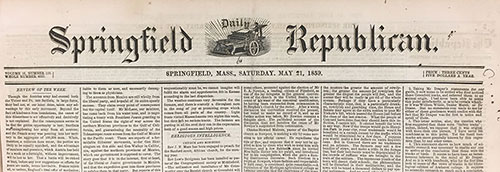
The Springfield Republican has been in continuous publication since 1824, when it began as a weekly. Image courtesy of Pocumtuck Valley Memorial Association Library.
Samuel Bowles II (1797-1851) began publishing the Springfield Republican in Springfield, Massachusetts, as a weekly paper in 1824. From the beginning, the paper made a point of reporting local stories from towns throughout the region as well as national news. Bowles groomed his son, Samuel Bowles III (1826-1878), to take over the paper. When he was only 18, the younger Bowles convinced his father to turn the paper into a daily and quickly became the principal editor. Under his leadership, the Springfield Republican became one of the leading newspapers in the nation.
In the 19th century, editors and readers took it for granted that most newspapers were strongly partisan in their politics. When a new coalition formed in 1854, around an antislavery platform, Samuel Bowles was quick to identify the Springfield Republican with the new national Republican party. A fine writer and editorialist, Bowles did not flinch from controversy. In 1859, the paper publicly dismissed Edward Hitchcock’s claim that he was the discoverer of fossil footprints, siding instead with James Deane (by then deceased) in what had become a heated public debate.
Samuel Bowles was widely admired for his intellectual and literary abilities. He counted the Dickinson family of Amherst among his close friends, including Emily Dickinson. Samuel published several of Emily's poems in the Republican between 1858 and 1862, making him one of the few people to publish her poetry during her lifetime.